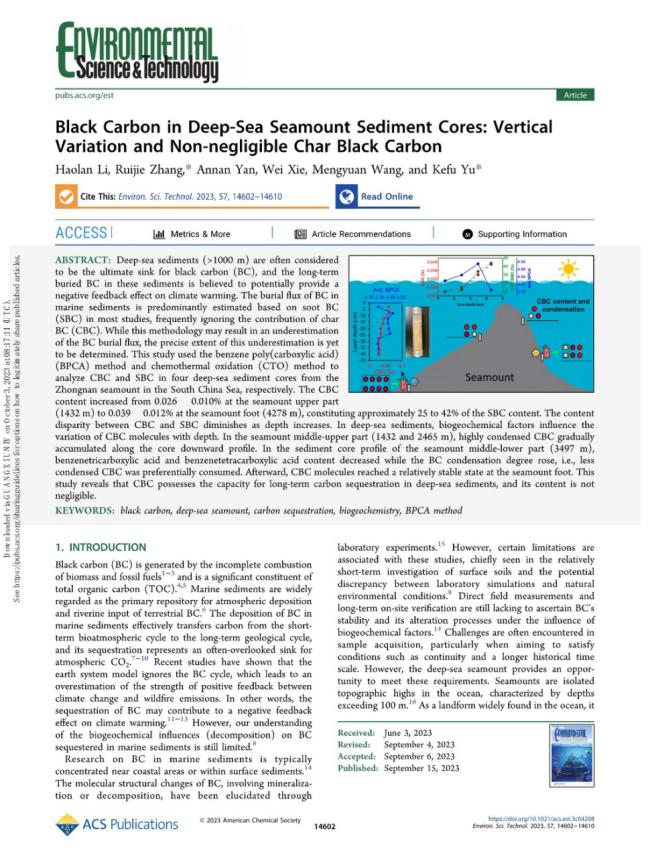Recently, research conducted by Master student Li Haolan under the guidance of Associate Professor Zhang Ruijie at GXU’s School of Marine Science has been featured as the cover article in the prestigious journal Environmental Science & Technology (IF=11.4). The study, titled Black Carbon in Deep-Sea Seamount Sediment Cores: Vertical Variation and Non-Negligible Char Black Carbon, received substantial support from the National Natural Science Foundation of China and the Southern Laboratory of Ocean Science and Engineering in Guangdong Province (Zhuhai).
Black carbon primarily originates from incomplete combustion of terrestrial biomass and fossil fuels. Deep-sea sediments are commonly considered the ultimate repository for black carbon (BC), with long-buried black carbon potentially exerting negative feedback effects on climate warming. Previous research often estimated burial fluxes of black carbon in marine sediments based primarily on soot black carbon (SBC), frequently overlooking the contribution of char black carbon (CBC).
Using the advantageous natural geography of deep-sea seamounts, Li Haolan’s research employed the benzene polycarboxylic acid (BPCA) method and chemical thermal oxidation (CTO) method to analyze CBC and SBC in sediment cores at different depths within the central South China Sea seamount (with a summit depth of 288 meters and a base depth of 4355 meters). The findings revealed that CBC content increased from 0.026±0.010% at the upper part of the seamount (1432 meters) to 0.039±0.012% near the seamount’s base (4278 meters), constituting approximately one-fourth to two-fifths of the SBC content. As depth increased, the difference in content between CBC and SBC gradually diminished. Within deep-sea sediments, biogeochemical factors influenced the vertical variations of CBC molecules. In sediment columns of the upper part of the seamount (1432 meters and 2465 meters), highly condensed CBC molecules gradually accumulated along the sediment column profile. Upon reaching the lower part of the seamount (3497 meters), the decrease in benzene tricarboxylic acid (B3CA) and benzene tetracarboxylic acid (B4CA) content accompanied an increase in CBC condensation, indicating that less condensed CBC was preferentially consumed. Subsequently, CBC molecules reached a relatively stable state at the seamount's base. This study suggests that CBC possesses the capability for long-term carbon sequestration in deep-sea sediments, and previous calculations of burial fluxes in marine sediments, solely based on SBC, underestimated the actual values by approximately 20-30%. This research provides a vital theoretical foundation for reevaluating sediment BC burial fluxes and exploring the mutual interactions between black carbon and climate warming.
